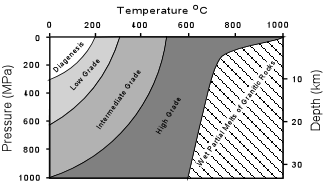
| EENS 212 |
Petrology |
| Prof. Stephen A. Nelson |
Tulane University |
|
Metamorphic Rocks- Classification, Field Gradients, & Facies |
|
Metamorphism is defined as follows:
Grade of Metamorphism As the temperature and/or pressure increases on a body of rock we say the rock undergoes prograde metamorphism or that the grade of metamorphism increases. Metamorphic grade is a general term for describing the relative temperature and pressure conditions under which metamorphic rocks form.
|
|
|
 |
|
Types of Metamorphism Contact Metamorphism |
| Since only a small area surrounding the intrusion is heated by the magma, metamorphism is restricted to the zone surrounding the intrusion, called a metamorphic or contact aureole. Outside of the contact aureole, the rocks are not affected by the intrusive event. The grade of metamorphism increases in all directions toward the intrusion. Because the temperature contrast between the surrounding rock and the intruded magma is larger at shallow levels in the crust where pressure is low, contact metamorphism is often referred to as high temperature, low pressure metamorphism. The rock produced is often a fine-grained rock that shows no foliation, called a hornfels. | 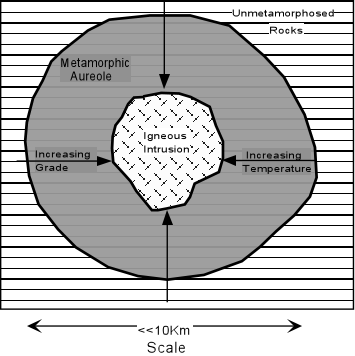 |
| Regional Metamorphism |
| Cataclastic Metamorphism |
| Hydrothermal Metamorphism |
| Burial Metamorphism Shock Metamorphism (Impact Metamorphism)
|
Classification of Metamorphic Rocks Classification of metamorphic rocks is based on mineral assemblage, texture, protolith, and bulk chemical composition of the rock. Each of these will be discussed in turn, then we will summarize how metamorphic rocks are classified.
This series can, in a rather general way, enable us to determine the origin of a given rock. For example a rock that shows euhedral plagioclase crystals in contact with anhedral amphibole, likely had an igneous protolith, since a metamorphic rock with the same minerals would be expected to show euhedral amphibole in contact with anhedral plagioclase. Another aspect of the crystalloblastic series is that minerals high on the list tend to form porphyroblasts (the metamorphic equivalent of phenocrysts), although K-feldspar (a mineral that occurs lower in the list) may also form porphyroblasts. Porphyroblasts are often riddled with inclusions of other minerals that were enveloped during growth of the porphyroblast. These are said to have a poikioblastic texture. Most metamorphic textures involve foliation. Foliation is generally caused by a preferred orientation of sheet silicates. If a rock has a slatey cleavage as its foliation, it is termed a slate, if it has a phyllitic foliation, it is termed a phyllite, if it has a shistose foliation, it is termed a schist. A rock that shows a banded texture without a distinct foliation is termed a gneiss. All of these could be porphyroblastic (i.e. could contain porhyroblasts). A rock that shows no foliation is called a hornfels if the grain size is small, and a granulite, if the grain size is large and individual minerals can be easily distinguished with a hand lens. Protolith Bulk Chemical Composition
Just like in igneous rocks, minerals can only form if the necessary chemical constituents are present in the rock (i.e. the concept of silica saturation and alumina saturation applies to metamorphic rocks as well). Based on the mineral assemblage present in the rock one can often estimate the approximate bulk chemical composition of the rock. Some terms that describe this general bulk chemical composition are as follows:
In addition to these conventions, certain non-foliated rocks with specific chemical compositions and/or mineral assemblages are given specific names. These are as follows:
Quartzites: Quartz arenites and chert both are composed mostly of SiO2. Since quartz is stable over a wide range of pressures and temperatures, metamorphism of quartz arenites and cherts will result only in the recrystallization of quartz forming a hard rock with interlocking crystals of quartz. Such a rock is called a quartzite. Serpentinites: Serpentinites are rocks that consist mostly of serpentine. These form by hydrothermal metamorphism of ultrabasic igneous rocks. Soapstones: Soapstones are rocks that contain an abundance of talc, which gives the rock a greasy feel, similar to that of soap. Talc is an Mg-rich mineral, and thus soapstones from ultrabasic igneous protoliths, like peridotites, dunites, and pyroxenites, usually by hydrothermal alteration. Skarns: Skarns are rocks that originate from contact metamorphism of limestones or dolostones, and show evidence of having exchanged constituents with the intruding magma. Thus, skarns are generally composed of minerals like calcite and dolomite, from the original carbonate rock, but contain abundant calcium and magnesium silicate minerals like andradite, grossularite, epidote, vesuvianite, diopside, and wollastonite that form by reaction of the original carbonate minerals with silica from the magma. The chemical exchange is that takes place is called metasomatism. |
| Metamorphic Facies In general, metamorphic rocks do not drastically change chemical composition during
metamorphism, except in the special case where metasomatism is involved (such as in the
production of skarns, as discussed above). The changes in mineral assemblages are
due to changes in the temperature and pressure conditions of metamorphism. Thus, the
mineral assemblages that are observed must be an indication of the temperature and
pressure environment that the rock was subjected to. This pressure and temperature
environment is referred to as Metamorphic Facies. (This is similar to
the concept of sedimentary facies, in that a sedimentary facies is also a set of
environmental conditions present during deposition). The sequence of metamorphic
facies observed in any metamorphic terrain, depends on the geothermal gradient that was
present during metamorphism. |
| A high geothermal gradient such as the one labeled "A" , might be present around an igneous intrusion, and would result in metamorphic rocks belonging to the hornfels facies. Under a normal to high geothermal gradient, such as "B", rocks would progress from zeolite facies to greenschist, amphibolite, and eclogite facies as the grade of metamorphism (or depth of burial) increased. If a low geothermal gradient was present, such the one labeled "C" in the diagram, then rocks would progress from zeolite facies to blueschist facies to eclogite facies. | 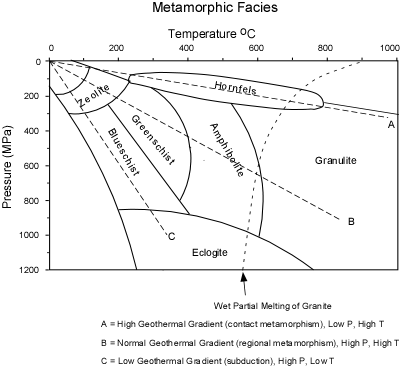 |
| Thus, if we know the facies of metamorphic rocks in the region, we can determine what
the geothermal gradient must have been like at the time the metamorphism occurred.
This relationship between geothermal gradient and metamorphism will be the
central theme of our discussion of metamorphism.
|
|
The facies concept was developed by Eskola in 1939. The names of Eskola's facies are based on mineral assemblages found in metabasic basic rocks.
|
|
Estimating Pressure and Temperature of Metamorphism Using combinations of reactions that have likely taken place during metamorphism, petrologists have been able over the years to determine the pressure and temperature of metamorphism in a variety of rocks, and in so doing have been able to place constraints on the fields of temperature and pressure for the various metamorphic facies. Some of these reactions that have been determined experimentally, are shown in the diagram below with reaction boundaries superimposed over the facies diagram. |
|
|
The diagram also shows various geothermal gradients that would control the succession
of facies encountered during prograde metamorphism if the rocks were pushed down into the
Earth along one of these geothermal gradients.
|
|
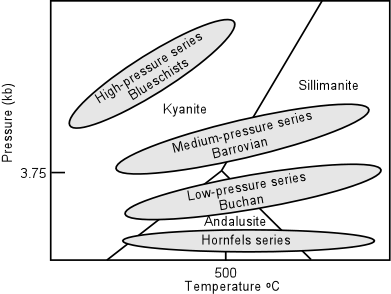 |
Note that a slightly higher geothermal gradient would produce the same succession of
facies, but pelitic rocks would show a change in the Al2SiO5
minerals from kyanite to andalusite to sillimanite. This facies series is
called the Low-pressure series or Buchan facies series. |
Metamorphic Field Gradients As rocks are pushed deeper into the Earth as a result of tectonism, they will encounter four stages during which temperature and pressure change in the rock in different ways. |
|
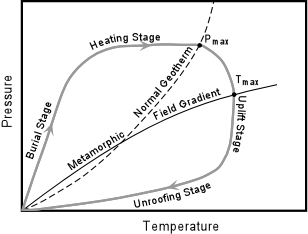 |
Since chemical equilibrium will be controlled more by temperature than by pressure, the mineral assemblages will reflect those stable at the maximum temperature, but not necessarily the maximum pressure. Thus, the geothermal gradient deduced from a series of rocks in any area will reflect a thermal gradient somewhat higher than the true geothermal gradient. To distinguish between the true geothermal gradient and that deduced from the facies series, the deduced geothermal gradient is called the metamorphic field gradient. |
| Metamorphic field gradients can also be used to define metamorphic facies series for specific metamorphic belts, as shown in the diagram below. Here, in addition to the contact, Buchan, and Barrovian Series, discussed above, are shown the facies series and metamorphic field gradients deduced for the Franciscan rocks in California and the Sanbagawa belt rocks of Japan. These will be discussed in more detail in our lecture on regional metamorphism. |
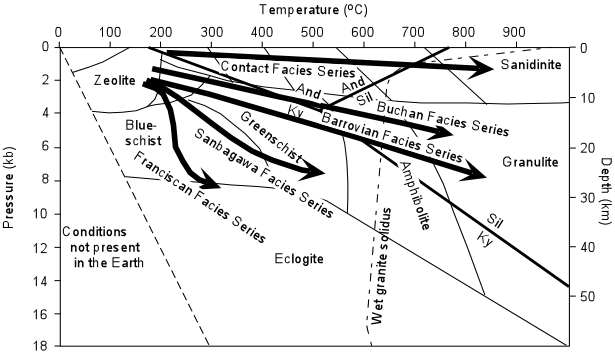 |
| Return to EENS 212 Home Page |